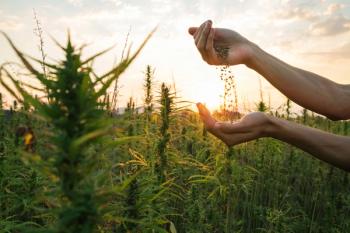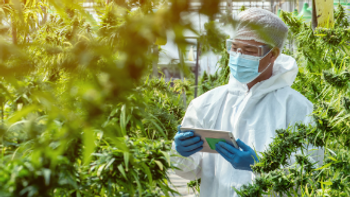
Cannabis Science and Technology
- March 2020
- Volume 3
- Issue 2
Low Oxygen: A New Method for Cannabis Cultivation

An interview with Todd Bell about the experiments and findings his group is working on with controlled atmospheres in cannabis cultivation.
An interview with Todd Bell about the experiments and findings his group is working on with controlled atmospheres in cannabis cultivation.
With the cannabis industry continuously expanding, new technologies and methods are coming forth to increase yields and production in cannabis cultivation. One such method involves using controlled atmospheres and low oxygen with the cannabis plant to increase yields and terpene levels. Here Todd Bell, Research & Development at Grow Controlled, LLC, goes into further detail regarding the experiments and findings his group is working on with controlled atmospheres.
Can you tell us a little about Grow Controlled LLC and the role you play in the cannabis market?Todd Bell: Grow Controlled is an automation and controls company that specializes in custom built heating, ventilation, and air conditioning (HVAC) as well as refrigeration systems for cannabis cultivation and controlled atmospheres for short and long-term cannabis storage and preservation. Our primary focus is maintaining and optimizing environments for every phase of the cultivation and post-harvest process.
What have you found to be the most effective way to cultivate cannabis?
Bell: We’ve only cultivated in organic soil. Grow Controlled isn’t seeking the best or worst cultivation method, we’re focused on providing the perfect environment in the most efficient and sustainable manner possible. Regardless of the method (hydroponics, aeroponics, or organic), the Grow Controlled system will streamline any indoor cultivation method. We have proven controls in greenhouse space as well as indoor grows. The Grow Controlled system provides the highest grams produced/KW of energy used possible.
How does low oxygen produce better yield from the plants?
Bell: To date, we are on the third cycle of low oxygen trials. The first two cycles were centered on programming for pinpoint environmental accuracy during all phases of the flower cycle. Plant health and yield was secondary. We did measure the liters of water being fed by irrigation and the amount of moisture being removed via dehumidification.
After two trials, we’ve seen the low oxygen rooms have a higher transpiration rate and 12% yield increase. The yield increase is nice, but the 28% terpene increase is the most encouraging. We’ve just started the trials and look forward to sharing the data.
How does this method differ from other methods in the industry?
Bell: Growing in low oxygen requires gas tight rooms with limited air exchange. The only fresh air introduced in our chambers is supplemental high efficiency particulate air (HEPA) filtered air added when necessary. Many growing chambers are designed for ventilation with a fresh air exchange. The most common pests and pathogens are introduced via “fresh” air exchange.
How do your products help reduce contamination (such as mold and other impurities)?
Bell: Biosecurity is the most crucial detail in a cannabis facility. Simply stated, all of our grow chambers and post-harvest technology is sealed and gas tight. Our insulated metal panels (IMP) are sealed with flexible seam tape and paint. The Grow Controlled HVAC and refrigeration system uses a four pipe, heat transfer coefficient (HTC) secondary fluid that eliminates the need for multiple standalone hanging dehumidifiers. Stand-alone dehumidifiers are microbial magnets that require constant maintenance and sterilization. Doors are a major contributor to contamination breeches. We offer three different door options that assist with biosecurity.
How do you keep record of quality control in your laboratory?
Bell: The Grow Controlled laboratory is designed and built to collect environmental data. All environmental data is logged in our KiloWatch energy management system. The KiloWatch system monitors and controls data points from our in-house environmental probes and sensors in grow chambers. Our programmers work with each client to customize the system to the metrics and data points that are relevant to their operations.
Regarding your grow lab, what have you found to be the least effective method for cultivation?
Bell: We’ve only cultivated with organic soil. Our focus is to create the perfect growing environment that can be applied to any method of cultivation.
How does a gas tight room replicate similar altitudes of mountainous regions?
Bell: By lowering the oxygen in the room at any elevation, the partial pressure of oxygen is reduced on the plant to allow easier photosynthesis to occur. For example, atmosphere air at 18,000 feet on a mountain top is still 21.0%, but the atmospheric pressure is reduced up there. By reducing the oxygen to 10.5%, the barometric pressure is 14.9 compared to 29.9 at standard elevation. This Grow Controlled Pressure Atmosphere (GCPA) method is patent pending.
What are the advantages and disadvantages of this?
Bell: Some advantages we are seeing, mentioned earlier, are the increased yields and terpenes. We are also experimenting with changing the light cycles from a 12/12 cycle to 10/10 to increase “days” in a year, thereby increasing your bottom line. Finding the sweet spot of daytime hours for each phenotype may take years, but it is our goal as the industry continues to mature. A disadvantage is the need to air the room up to 19.5% or higher oxygen before entering to do work. However, this actually becomes an advantage as well since we are limiting easy access and fewer microbial transfers by workers.
What are the next steps for your company in cultivation and post-harvest research?
Bell: Our next trials, along with light cycles, will focus on the life cycle of insects and molds under low oxygen environments. Insects can survive an extended period of time in low oxygen environments. However, we believe the ability for insects to reproduce is greatly compromised in low oxygen environments.
References:
About the Author
Madeline Colli is the Associate Editor for Cannabis Science and Technology. Direct correspondence to:
How to Cite this Article
M. Colli, Cannabis Science and Technology3(2), 46–47 (2020).
Articles in this issue
almost 6 years ago
Are There Limits to the Range of Possible Cannabinoid Ratios in Plants?almost 6 years ago
Cannabis Laboratory Testing Market in North AmericaNewsletter
Unlock the latest breakthroughs in cannabis science—subscribe now to get expert insights, research, and industry updates delivered to your inbox.



